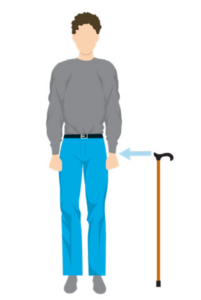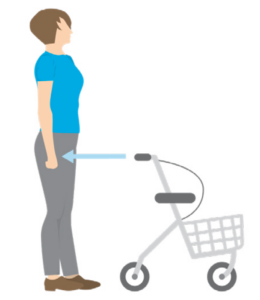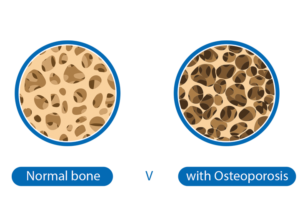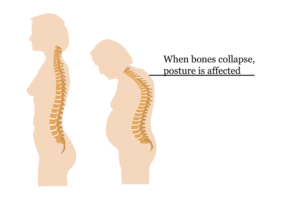How to measure a Walking Stick

Note: If a cane is too high or too low, it can aggravate a neck, shoulder, hip or back problem but also affect your balance.
How to measure a Rollator (walker with wheels or without wheels)

Note: If a Rollator is too high or too low, it can aggravate a neck, shoulder, hip or back problem.

What is Osteoporosis?
Osteoporosis is a disease that affects the inside of your bones, making them fragile. The images above show how Osteoporosis causes large holes to develop in the inside of your bones, which is why they break easily. Broken bones are also known as fractures. Example: You have been told that you have fractured vertebrae/ collapsed vertebrae/crushed vertebrae, which all mean you have broken bones in your back.
What is Osteopenia?
Osteopenia is the early stages of Osteoporosis. Research shows that most broken bones (fractures) occur in the moderate to marked Osteopenia range, which is a DXA scan T score result of -1.5 to -2.49. FYI: A person can be diagnosed with Osteopenia in their hips and Osteoporosis in their back or the reverse.
Are Osteoporosis and Osteopenia treatable?
Yes, it is very rare when a person cannot improve their bones. We know of 90-year-olds who have improved their bone health.
Who is at risk of developing Osteoporosis?
Anyone can develop Osteoporosis, as it affects women and men of all age groups and can even affect children. You will not feel the insides of your bones getting thinner, which is why everyone should check to see if they have risk factors for bone loss. Women over 65 are the highest risk group affected as they will have gone through the menopause, which is when a significant amount of bone can be lost. 90% of fractured hips (broken hips) are due to Osteoporosis and 7 out of 10 hip fractures happen to women.
What are the risk factors for losing bone?
There are approximately 200 causes of bone loss. Some causes are secondary effects from other diseases, treatments for other diseases and others are lifestyle choices. The following are some of the many risk factors, the Menopause, Family history especially of a broken hip, Radiation, chemotherapy and some treatments for breast and prostate cancer. Rheumatoid arthritis, Coeliac disease/Gluten sensitivity and Low levels of sex hormones in females and males. Anorexia/Bulimia, over exercising, Lack of weight bearing exercise, many medications such as protein pump inhibitors, others that contain cortisone such as steroid asthmatic inhalers, some anti-depressants and some water pills, Low calcium and/or Vitamin d levels, Physiological or psychological stress, smoking and excess alcohol.
The signs and symptoms of possible undiagnosed Osteoporosis
